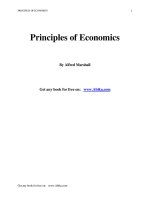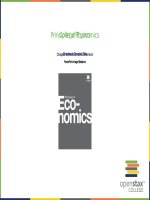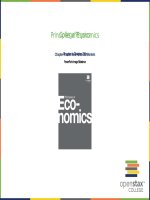Principles of economics openstax chapter3
Bạn đang xem bản rút gọn của tài liệu. Xem và tải ngay bản đầy đủ của tài liệu tại đây (660.75 KB, 27 trang )
College
Principles
ofPhysics
Economics
Chapter
# Chapter
Chapter
3 Demand
andTitle
Supply
PowerPoint Image Slideshow
Demand & supply
Organic vegetables and fruits locally grown and sold should cost less than regular produce because
of low transportation cost. That is not, however, usually the case.
Free Market System
Supply and Demand: the name of the most important model in all
economics
Market: a network of buyers and sellers negotiating prices
Price: the amount of money that must be paid for a unit of a good or
service
Quantity: the amount of a good or service bought or sold
Demand and Supply
Consumers: market participants buying goods and services
Producers: market participants selling goods and services
Equilibrium Price: the money payment at which consumers and producers
agree to transact
Equilibrium Quantity: the amount of output exchanged at the equilibrium price
Demand and Supply
Quantity Demanded: the amount of a good or service
consumers are willing and able to buy at a particular
price
Quantity Supplied: the amount of a good or service
producers are willing and able to sell at a particular
price
Demand and Supply
Demand shows the relationship between price and
quantity demanded, all being equal.
Supply shows the relationship between price and quantity
supplied, all being equal.
demand
The Law of Demand: quantity demanded and price are negatively related. The demand is downward
sloping.
Reasons: income effect and substitution effect.
supply
The Law of Supply: quantity supplied and price are positively related. The supply is upward sloping.
Reason: Profitability
Demand and Supply
Market Equilibrium: A condition at which independent
plans of consumers and producers coincide in the market
Demand = Supply to determine the equilibrium price and
quantity
No shortage or surplus
Demand and Supply
Shortage: At a price lower then the equilibrium price, quantity
demanded exceeds quantity supplied
Surplus: At a price higher then the equilibrium price, quantity
supplied exceeds quantity demanded
In a “free market,” price adjustments eliminate shortage or
surplus
Market equilibrium
Market equilibrium
Qd = qs @ price = $1.40
Price Quantity Demanded Quantity Supplied Shortage/Surplus
$1.00
800
500
300
$1.20
700
550
150
$1.40
600
600
0
$1.60
550
640
-90
$1.80
500
680
-180
$2.00
460
700
-240
$2.20
420
720
-300
SHIFT in demand
Increased demand is a shift to the right from D 0 to D1.
Decreased demand is a shift to the left from D 0 to D2.
Determinants of Demand
•
•
•
•
•
•
•
Consumer Taste or Preference
Consumer Income
Price of Substitute and Complementary Goods
Population: Number of Buyers
Expectations of Price Change
Sales Taxes
Government Subsidies
Determinants of Demand
With an increase in income, consumers will purchase larger quantities, causing the demand
curve to increase (shifting to the right).
SHIFT in supply
Increased supply is a shift to the right from S 0 to S2.
Decreased supply is a shift to the left from S 0 to S1.
Determinants of Supply
•
Price of Inputs (e.g., wages and salaries)
•
Production Technology
•
Price of Related Goods
•
Number of Sellers
•
Expectations of Price Change
MARKET FOR SALMON
Good weather to fish leads to and increase in supply of salmon, causing its price to
decline and quantity to increase.
MARKET FOR NEWSPAPER
A change in tastes from print news sources to digital sources results in a leftward shift in
demand for the former. The result is a decrease in both equilibrium price and quantity.
MARKET FOR POSTAL SERVICES
(a) Higher wages causes the supply to decline, decreasing the quantity, but increasing the price.
(b) Communicating by E-mail & Text-message causes the demand to decline, decreasing both
quantity and price.
Shift in demand & Supply
Supply and demand shifts cause changes in equilibrium price and quantity.
Price ceiling
When the government set the market price below the equilibrium price, causing a shortage.
At P = 500, shortage = 19 – 15 = 4
Price floor
When the government set the market price above the equilibrium price, causing a surplus.
At Pf > Pe, surplus = 19 – 15 = 4
Gains from trade
Gains from trade
Consumer Surplus: Total benefit to the consumer as a result of buying a good at the
equilibrium price.
Area of triangle F = 0.5(180 – 80)(28 – 0) = $1,120
Producer Surplus: Total benefit to the producer as a result of selling a good at the equilibrium
price.
Area of triangle G = 0.5(80 – 30)(28 – 0) = $700









